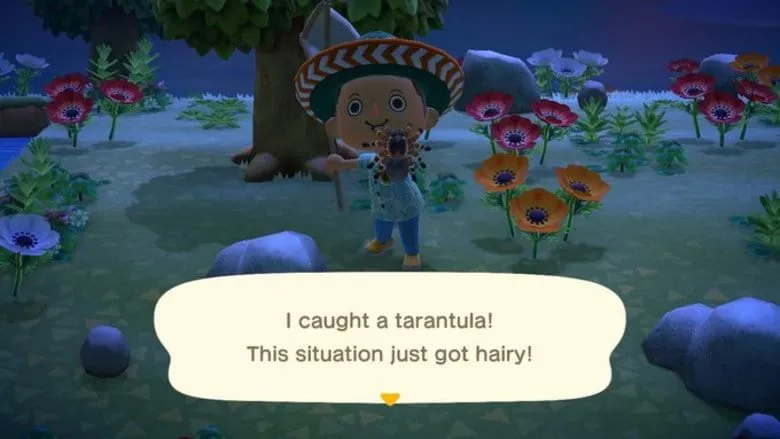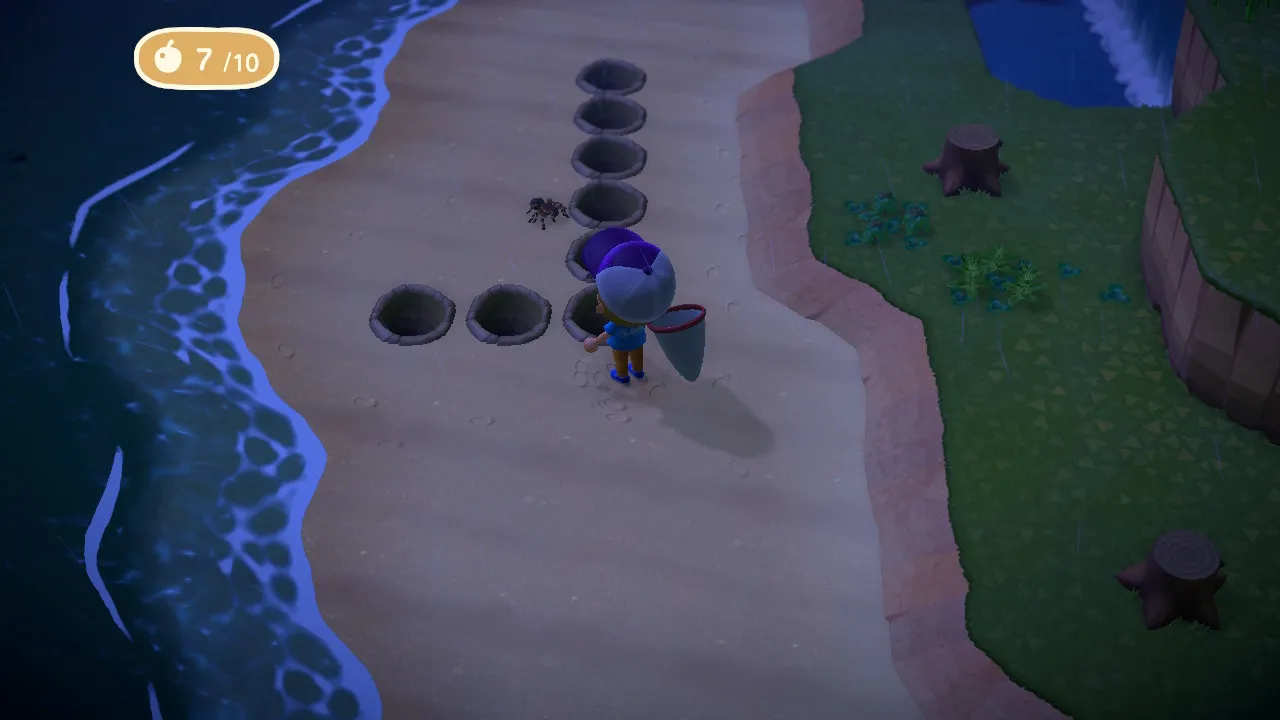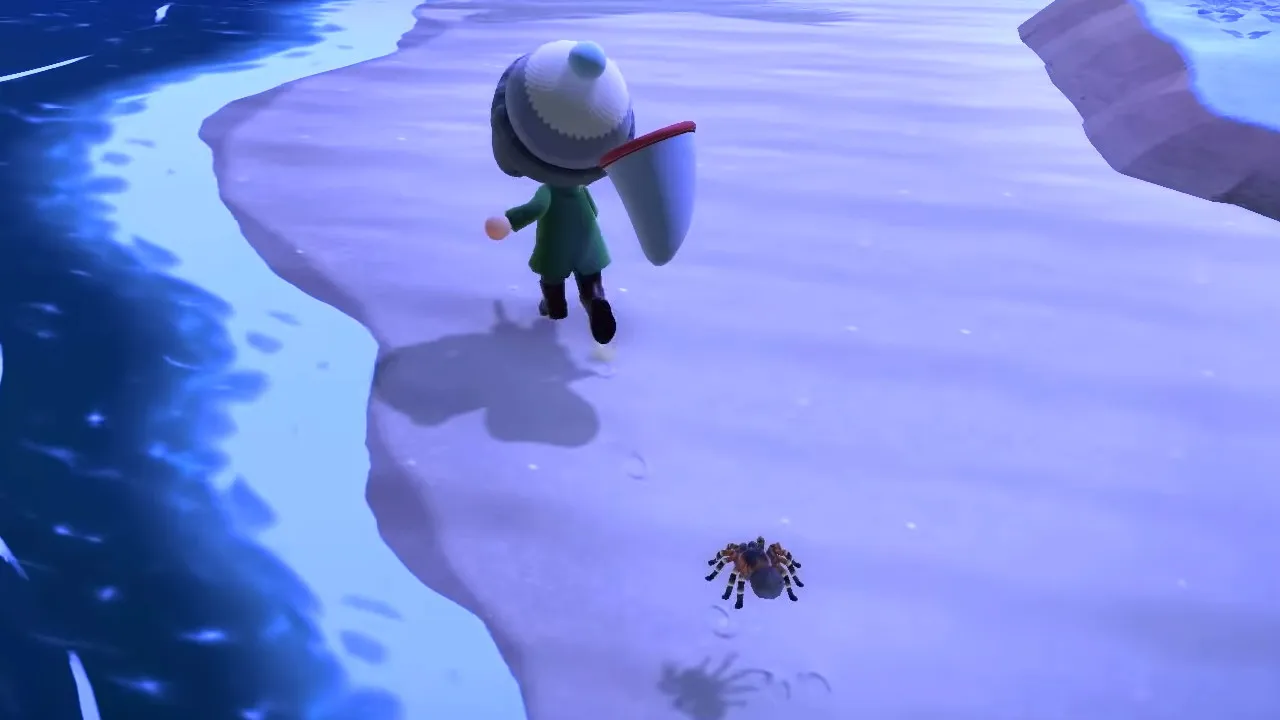What are Tarantulas in Animal Crossing
Tarantulas are one of the most valuable and sought-after insects in Animal Crossing New Horizons. These arachnids are not only a significant source of Bells (the game’s currency) but also a thrilling challenge for players. Tarantulas are known for their aggressive behavior; when approached, they will rear up and attempt to attack. This makes catching them a unique test of skill and patience. Their rarity and high selling price make tarantulas a key element for those looking to build wealth and complete their Critterpedia. Successfully catching a tarantula is a rewarding experience, offering bragging rights among players and a lucrative opportunity to enhance your island life.
Why Catch Tarantulas
The primary reason to catch tarantulas is their high value. Each tarantula sells for a substantial amount of Bells at Nook’s Cranny. This makes tarantula hunting an excellent way to earn money quickly, allowing you to upgrade your house, buy new items, and pay off your debts to Tom Nook. Beyond their monetary value, tarantulas are essential for completing the Critterpedia, which is a collection of all the insects, fish, and sea creatures available in the game. Capturing a tarantula and donating it to Blathers at the museum ensures that you fill this crucial part of the collection. Finally, the challenge and excitement of catching tarantulas add a fun and engaging element to the gameplay, making your Animal Crossing experience more dynamic.
Where to Find Tarantulas

Tarantulas appear on your island during specific times of the day and year. Generally, they spawn between 7 PM and 4 AM. The spawn rate is also affected by the island’s environment and the presence of other bugs. However, the most efficient method involves visiting Mystery Islands via Nook Miles Tickets. These islands often have a higher spawn rate for rare bugs. If the island is filled with other insects, you’ll need to clear them out to increase your chances. You can do this by running around and scaring them away or by catching them. This will eventually give you more tarantula spawns. Remember that tarantulas are more likely to spawn on flat ground areas, so it’s best to clear any objects that may be in their way.
Best Time to Catch Tarantulas
The best time to catch tarantulas in Animal Crossing is during the late evening and early morning hours, specifically from 7 PM to 4 AM. During this period, tarantulas are most active, and their spawn rate increases. Keep in mind that the availability of tarantulas also varies by season. They appear more frequently during certain months, typically in the Northern Hemisphere from November to April. Always check the time on your Nintendo Switch and the current season in the game before you start your hunt. This will help you maximize your chances of finding tarantulas. Also, be mindful of the weather, as rain can impact bug spawns. Clear nights are usually the best for a successful tarantula hunt.
Tools and Preparation
Before embarking on your tarantula hunting adventure, you’ll need a few essential items. Firstly, you must have a sturdy net, which is the key tool to catch tarantulas. Make sure your net is in good condition to avoid any unexpected breaks. Additionally, empty your pockets as much as possible to make room for all the tarantulas you catch. This will allow you to catch more tarantulas without having to run back to sell or store them. Consider crafting or buying a stack of Nook Miles Tickets if you plan to visit Mystery Islands. These tickets are your gateway to potentially lucrative tarantula hunting grounds. Lastly, wear comfortable in-game clothing, as you might be running around for a while. It’s all about preparation and readiness.
Step-by-Step Guide to Catching Tarantulas

The process of catching a tarantula involves a combination of patience, precision, and strategic movement. First, locate a tarantula; they typically roam the island. When you spot one, approach slowly. Hold down the A button to equip your net and slowly approach the tarantula. If the tarantula starts to rear up and raise its legs, stop immediately. Wait for it to calm down before advancing. The key is to maintain a safe distance while closing in. Once you’re close enough, quickly swing your net to catch it. If done correctly, you will capture the tarantula. Be prepared to repeat this process, as it might take a few attempts to master the technique. Remember to stay calm and focused, and you’ll become a successful tarantula hunter in no time.
Approaching Tarantulas
Approaching a tarantula requires a careful and methodical approach. The most important aspect is to move slowly. Hold down the A button to equip your net and slowly advance towards the tarantula. If the tarantula starts to react, stop immediately. It will stand on its hind legs, ready to attack. Stay still until it calms down and returns to its normal position. Then, take another small step. Repeat this process, inching closer with each movement. By doing this, you minimize the risk of startling the tarantula, allowing you to get within range without triggering an attack. Patience is your best tool when approaching a tarantula, as rushing the process often leads to failure. Practice and you’ll master the art of the slow approach.
Catching Tarantulas Successfully
Successfully catching a tarantula relies on perfect timing and a steady hand. Once you’re close enough after your slow approach, quickly swing your net by pressing the A button. The timing is crucial; you want to swing just as you’re within range of the tarantula. Aim for the space directly in front of the tarantula to maximize your chances of success. If you’re too far away, you’ll miss. If you’re too close, you risk being bitten. If you miss, don’t panic. Quickly run away to avoid being attacked. Then, try the approach again. With practice, you’ll develop a feel for the correct distance and timing, making it easier to catch tarantulas consistently. Celebrate your success; you have caught a valuable prize. Keep in mind that you can also get bitten, but don’t get discouraged; it is part of the process.
What to do with Tarantulas

Once you’ve successfully caught a tarantula, you have several options. The most common is to sell it at Nook’s Cranny. Each tarantula sells for a significant amount of Bells, making it a valuable commodity. You can also donate the tarantula to the museum, where it will be displayed in the insect exhibit, next to the other bugs you’ve donated. Donating tarantulas will help you complete your Critterpedia. Another option is to use the tarantula to craft various DIY recipes if you find any recipes that require them. Consider your goals: earning Bells, completing your museum collection, or expanding your DIY repertoire. Each path offers its own rewards, enhancing your Animal Crossing experience.
Selling Tarantulas
Selling tarantulas is a straightforward process. Simply visit Nook’s Cranny, the shop run by Timmy and Tommy. Inside, speak to either of them and select the option to sell items. Choose the tarantulas from your inventory. Each tarantula will be sold for a set price, adding to your Bells. Selling tarantulas is a great way to quickly earn money. Consider selling your haul as often as possible to maximize your income. Additionally, keep an eye out for special events or days when Nook’s Cranny might offer bonus prices for selling insects. Sometimes, the shop might also offer a higher buying price, so it is always a good idea to keep an eye on the game’s updates.
Displaying Tarantulas
Besides selling tarantulas, you can display them in various ways. The museum is one of the best ways to display them; donate a tarantula to Blathers, the museum curator. The insect exhibit will then feature the tarantula. You can also decorate your island. Place them around your home or in your garden to add a unique touch to your island. Some players create small displays or terrariums, while others place them as part of larger themed areas. Displaying tarantulas is a great way to showcase your achievements and share your catches with friends who visit your island. Display your collection creatively; it’s a mark of your dedication as a tarantula hunter.
Other Rare Bugs to Catch

Animal Crossing New Horizons features a variety of rare and valuable bugs beyond tarantulas. In the summer, you can hunt for the Giant Stag, which is a valuable insect found on trees. During the warmer months, you can find the Horned Hercules, another sought-after beetle. Also, consider searching for the Golden Stag, which is another rare and expensive beetle. During the day, look for butterflies like the Emperor Butterfly and the Rajah Brooke’s Birdwing. All of these insects sell for a good price. Expanding your insect-catching horizons will diversify your gameplay. Tracking down these other rare bugs keeps the game fresh and provides more opportunities to earn Bells and expand your Critterpedia.
Tips for Bug Hunting in Animal Crossing
Successful bug hunting in Animal Crossing requires a few key strategies. Always be patient and observe the environment. Look for the specific conditions that attract different bugs. Keep an eye on the time and the season. Check your Critterpedia regularly to track which bugs are available and when. Make sure you have a reliable net and enough space in your inventory. Remember to clear out any existing bugs to increase the spawn rate of the ones you want. For tarantulas, this often means clearing out other bugs on the Mystery Islands. Learn the specific approach techniques needed for different bugs, such as tarantulas and scorpions. Staying focused and well-prepared will turn you into a master bug hunter. Happy hunting!
